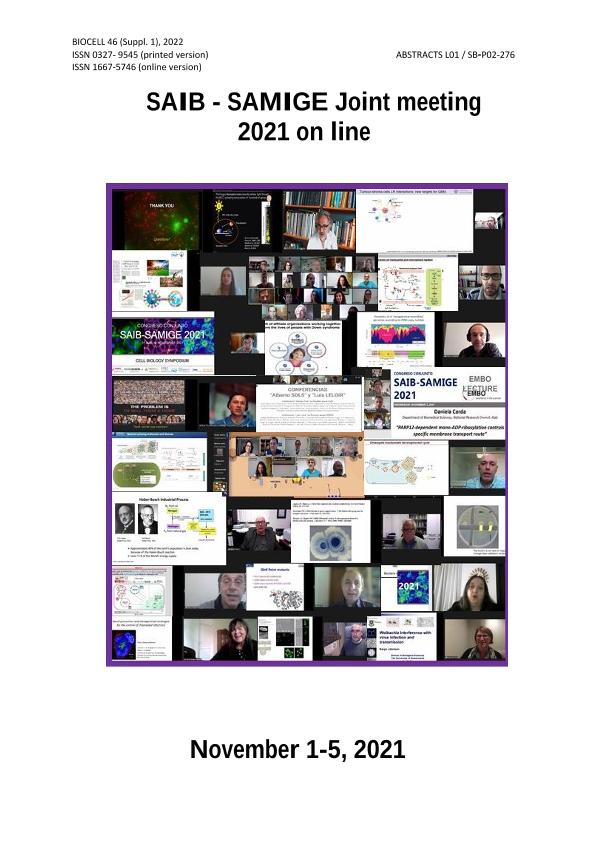Mostrar el registro sencillo del ítem
dc.contributor.author
Vázquez, Nicolás Martín

dc.contributor.author
Moreno, Silvia

dc.contributor.author
Galvan, Estela Maria

dc.date.available
2022-06-02T04:19:09Z
dc.date.issued
2021
dc.identifier.citation
1,8-cineole as an antimicrobial and antibiofilm agent against multidrug resistant Klebsiella pneumoniae; LVII Annual Meeting of the Argentine Society for Biochemistry and Molecular Biology Research; XVI Annual Meeting of the Argentinean Society for General Microbiology; Ciudad Autónoma de Buenos Aires; Argentina; 2021; 114-114
dc.identifier.issn
0327-9545
dc.identifier.uri
http://hdl.handle.net/11336/158719
dc.description.abstract
Klebsiella pneumoniae is a common cause of antimicrobial-resistant opportunistic infections in hospitalized patients, including urinary tract infections. The emergence of multidrug-resistant (MDR) strains producing extended-spectrum β-lactamases (ESBL) and/or carbapenemases, in combination with the capacity to produce biofilm has created additional problems in providing adequate antibiotic treatment of urinary tract infections. Biofilms are complex bacterial communities adhered to biotic or abiotic surfaces that are surrounded by an extracellular matrix composed of exopolysaccharides, proteins and nucleic acids that give them differential phenotypic properties associated with greater resistance to antibiotics. 1,8-cineole, one of the main components of Rosmarinus officinalis volatile oil, has shown antimicrobial activity against non-MDR Gram negative bacteria (including K. pneumoniae) during planktonic growth. Here, we evaluated the antimicrobial and antibiofilm activity of 1,8-cineole against planktonic and pre-formed mature biofilms of non-MDR and MDR ESBL-producing K. pneumoniae clinical strains isolated from urinary tract infections. Killing curves were performed in planktonic cultures by adding 1% (v/v) 1,8-cineole for 5-180 min and counting viable cells (cfu/ml). Results showed variable decrease of K. pneumoniae viability (ranging from 0.5 to 4 log reduction) after phytochemical treatment, not related to their antibiotic resistance profile. Regarding biofilms, all tested strains formed robust biomass after 48 h, as determined by crystal violet staining (Abs 595nm > 1). One-hour treatment with 1% (v/v) 1,8-cineole partially disrupted biofilm biomasses (34 to 62% reduction in crystal violet staining). Additionally, a variable decrease in cell viability (between 0,5 and 4 log reduction of ufc/cm2 ) was observed by viable cell counting, regardless if they were or not MDR. Two MDR ESBL-producing K. pneumoniae strains, presenting different susceptibility to 1,8-cineole, were chosen to study their extracellular matrix in biofilms by confocal laser scanning microscopy after calcofluor white staining. Noteworthy, differences in the extracellular matrix structure were observed between strains, that could account for differences in 1,8-cineole susceptibility. Altogether, our results show that some antibiotic-sensitive and MDR ESBL-producing K. pneumoniae isolates were sensitive to 1,8-cineole exposure and support the efficacy of 1,8-cineole as a potential antimicrobial agent for the treatment of planktonic and biofilm-associated infections caused by MDR K. pneumoniae.
dc.format
application/pdf
dc.language.iso
eng
dc.publisher
Tech Science Press

dc.rights
info:eu-repo/semantics/openAccess
dc.rights.uri
https://creativecommons.org/licenses/by-nc-sa/2.5/ar/
dc.subject
KLEBSIELLA PNEUMONIAE
dc.subject
BIOFILM
dc.subject
PHYTOCHEMICAL AS ANTIBIOFILM
dc.subject.classification
Biología Celular, Microbiología

dc.subject.classification
Ciencias Biológicas

dc.subject.classification
CIENCIAS NATURALES Y EXACTAS

dc.title
1,8-cineole as an antimicrobial and antibiofilm agent against multidrug resistant Klebsiella pneumoniae
dc.type
info:eu-repo/semantics/publishedVersion
dc.type
info:eu-repo/semantics/conferenceObject
dc.type
info:ar-repo/semantics/documento de conferencia
dc.date.updated
2022-05-12T06:24:13Z
dc.identifier.eissn
1667-5746
dc.journal.volume
46
dc.journal.number
1
dc.journal.pagination
114-114
dc.journal.pais
Estados Unidos

dc.description.fil
Fil: Vázquez, Nicolás Martín. Universidad Maimónides. Área de Investigaciones Biomédicas y Biotecnológicas. Centro de Estudios Biomédicos, Biotecnológicos, Ambientales y de Diagnóstico; Argentina. Laboratorio de Biotecnologia Bacteriana.; Argentina. Consejo Nacional de Investigaciones Científicas y Técnicas; Argentina
dc.description.fil
Fil: Moreno, Silvia. Universidad Maimónides. Área de Investigaciones Biomédicas y Biotecnológicas. Centro de Estudios Biomédicos, Biotecnológicos, Ambientales y de Diagnóstico; Argentina. Consejo Nacional de Investigaciones Científicas y Técnicas; Argentina
dc.description.fil
Fil: Galvan, Estela Maria. Laboratorio de Biotecnologia Bacteriana.; Argentina. Consejo Nacional de Investigaciones Científicas y Técnicas; Argentina
dc.relation.alternativeid
info:eu-repo/semantics/altIdentifier/url/https://congresos.g2consultora.com/congreso-conjunto-saib-samige-2021/
dc.relation.alternativeid
info:eu-repo/semantics/altIdentifier/url/http://www.saib.org.ar/sites/default/files/TSP_BIOCELL_46213-SAIB-SAMIGE%202021.pdf
dc.conicet.rol
Autor

dc.conicet.rol
Autor

dc.conicet.rol
Autor

dc.coverage
Nacional
dc.type.subtype
Congreso
dc.description.nombreEvento
LVII Annual Meeting of the Argentine Society for Biochemistry and Molecular Biology Research; XVI Annual Meeting of the Argentinean Society for General Microbiology
dc.date.evento
2021-11-01
dc.description.ciudadEvento
Ciudad Autónoma de Buenos Aires
dc.description.paisEvento
Argentina

dc.type.publicacion
Journal
dc.description.institucionOrganizadora
Sociedad Argentina de Bioquímica e Investigación en Biología Molecular
dc.description.institucionOrganizadora
Sociedad Argentina de Microbiología General
dc.source.revista
Biocell
dc.date.eventoHasta
2021-11-05
dc.type
Congreso
Archivos asociados
